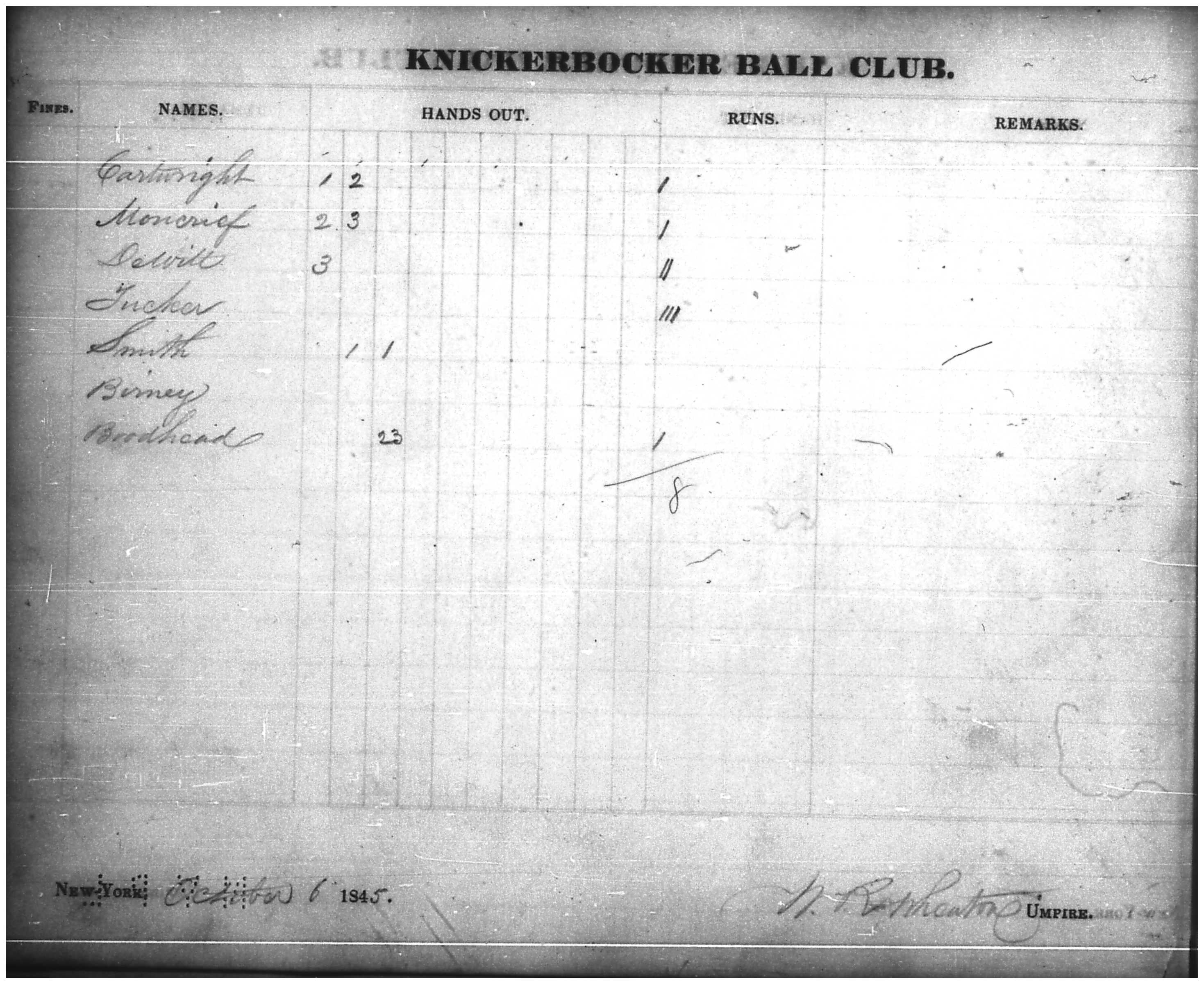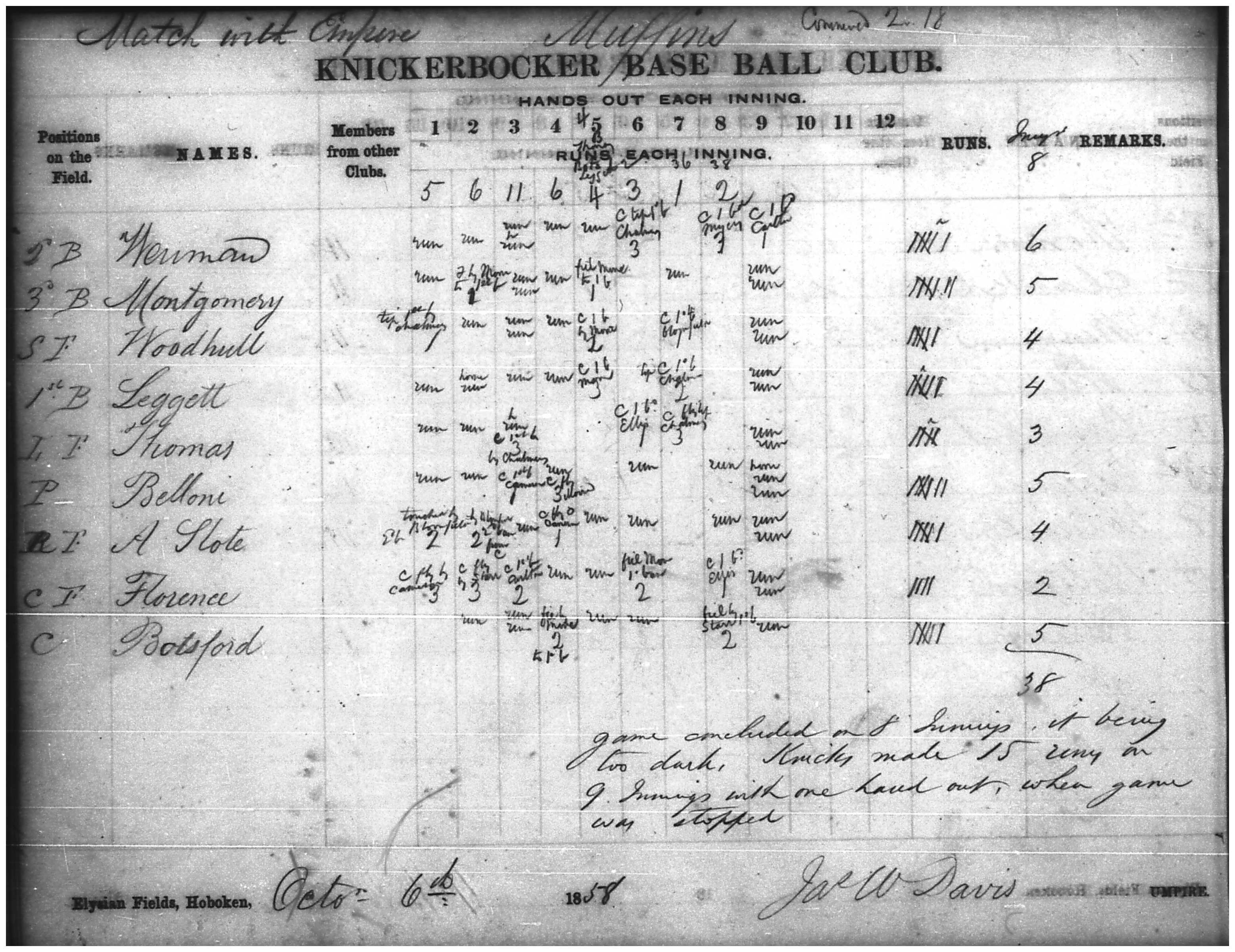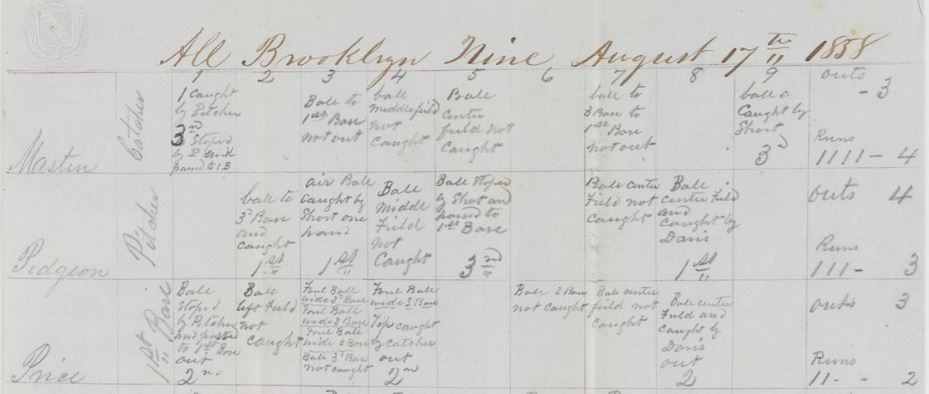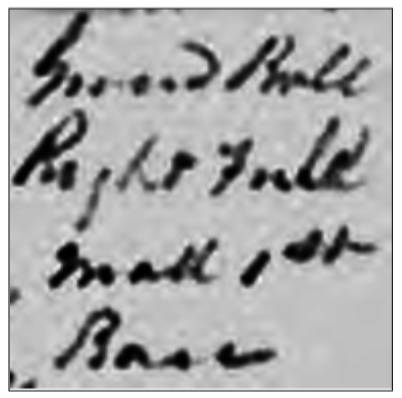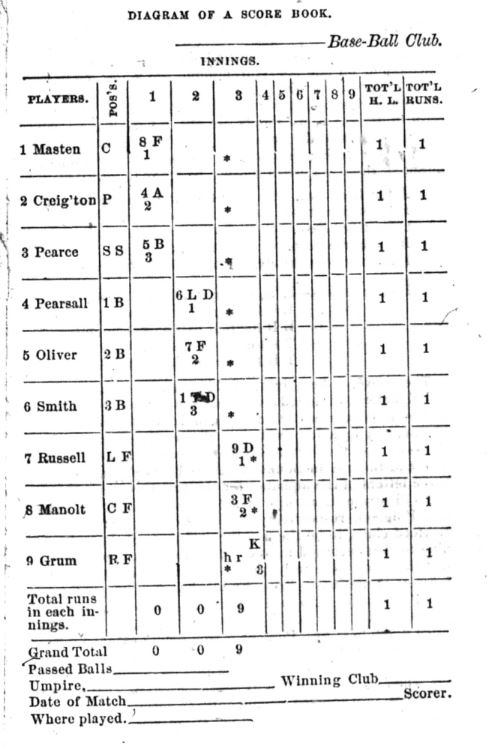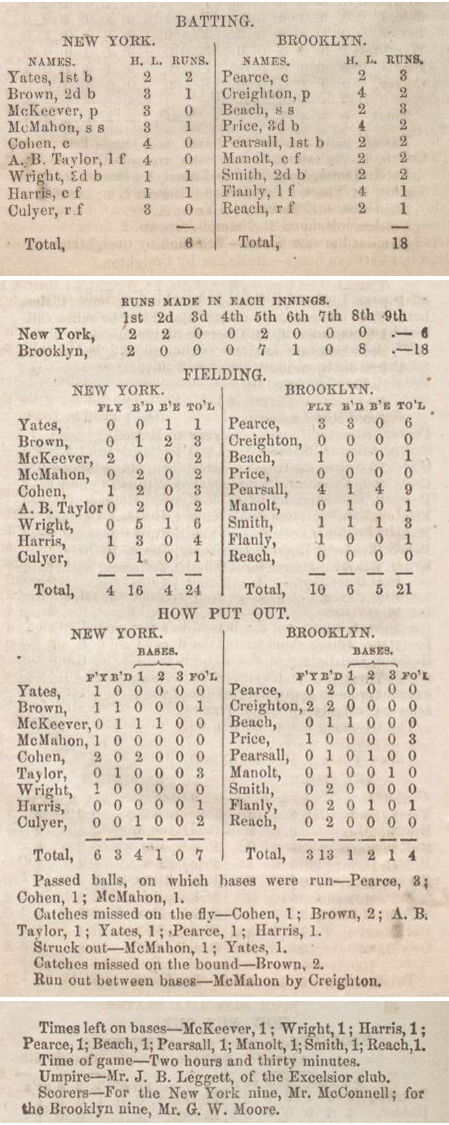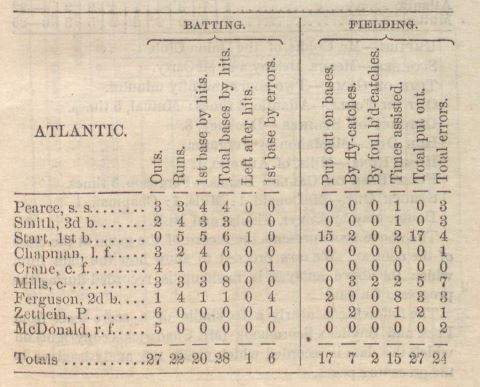From Recorder to Judge: The Evolution of the Scorer in the Nineteenth Century
This article was written by Robert Tholkes - Stew Thornley
This article was published in Fall 2017 Baseball Research Journal
Official scorers in baseball make judgments about the game—whether a play is a hit or an error—that influence individual statistics. This gives the official scorer more prominence in baseball than in other sports. The pay is greater, the attention more penetrating, the controversy often intense. Today’s official scorers sit in the hot seat, but until the 1870s, hits and errors were not routinely distinguished in game summaries.
In most early cases, scorers were merely recorders, not judges—although in the era before leagues, the scorers for the club teams did keep track to an unknown extent whether a batter reached base with a clean strike or if he got on because of poor fielding. Such records could be used by a club captain or committee to determine which players earned first-team status. Figure 1 shows the simplest of scoresheets, from a Knickerbocker intra-squad game on October 6, 1845, two weeks after the Knickerbockers established their rules on September 23, 1845. The numbers of outs, either at the bat or on the bases, and runs scored by each player were all that were recorded. (Teams weren’t required to have nine players; five per side were enough to get a game going.)
Figure 1
Figure 2
Click any images to enlarge. Note that the numerals on the right for the run totals don’t match the number of hash marks in the column to the left. A note on the scoresheet indicated the events of the Knickerbockers’ ninth inning were wiped out because the inning wasn’t completed before the game was stopped by darkness, which explains the different totals. (Photos courtesy of Stew Thornley)
A scoresheet of a match game of the Knickerbockers vs. Empire October 6, 1858, contains greater detail. (See Figure 2.)1 In match games, each team designated its own scorer, who kept a tally of what transpired. Such was the case in 1858 when selected players from New York and Brooklyn played a series of games on the Fashion Course Racetrack in Queens
The scoresheet from the second of these games survives.2 It contains the familiar grid for batters and innings. Figure 3 shows the outcomes of the plate appearances for Masten, Pidgeon, and Price, the first three strikers for the Brooklyn nine.
The shorthand and notations were not yet present. The description of Dickey Pearce’s at bat in the fifth inning, is merely, “Ground Ball Right Field Made 1st Base.” (See Figure 4.)
Figure 3
Figure 4
A game in which the Knickerbockers beat the Empire club, 59–33 on Wednesday, August 11, 1859, generated a game story that noted “unusually bad catching” and a section that included “Bad Misses During the Game.”3 Though such detail wasn’t the norm at the time, this account in the New York Sunday Mercury included a list of players and their “bad misses,” which totaled 15 for the teams combined. However, the main portion of the game summaries contained only outs and runs scored for each player in the batting order.
Scoresheets took on a different look in the 1860s as Henry Chadwick developed a new scoring system, which appeared in the 1861 Beadle’s Dime Base-Ball Player: A Compendium of the Game, edited by Chadwick. (See Figure 5.)
Figure 5

The numbers in the scoring grid note the sequence of a hand lost in an inning, as is the case for Masten, Creighton, and Pearce in the first inning. A number in the first line of an entry refers to the fielder, which is based on the batting order of the opposing team. The opposing team batting order in this case was as follows:
- Leggett, catcher
- M. O’Brien, pitcher
- McKinstry, short stop
- Price, first base
- Brown, second base
- Beach, third base
- P. O’Brien, left field
- J. Oliver, center field
- Whiting, right field
The letters carry meanings: A for first base, B for second base, C for third base, H for home base, F for catch on the fly, D for catch on the bound, L for foul balls, T for tips, K for struck out, R for run out between bases, HR for home runs, LF for foul ball on the fly, TF for tip on the fly, TD for tip on the bound. Chadwick had a semblance of order for the letters: the first three letters of the alphabet for the first three bases; the first letter in the words Home, Fly, and Tip, and the last letter in the words Bound, Foul, and Struck (which, of course, gives us the K for strike out that remains today).
In the scoresheet shown, Masten was put out when his fly to center was caught on the fly by Williams, the eighth batter in the order for his team. Creighton was put out at first by Price (assists were not tallied, so there is no indication if another fielder threw to Price). Pearce made his base but was out when he was not able to reach second safely on a batted ball by Pearsall.
Since Pearce was the final hand out in the first, Pearsall was the first striker in the second (even though he had been the final striker in the first) and was put out taken on the bound by Beach. Oliver was put out when his fly was caught on the fly by P. O’Brien. Smith tipped out on the bound to Leggett.4
Box scores of the period noted the number of hands lost (H.L.) and runs by each striker along with fielding statistics, such as the box score for the “Great Silver Ball Match” between picked nines from New York and Brooklyn on October 21, 1861. (See Figure 6.)5
Figure 6
When did the function of a scorer change from recorder to judge? It couldn’t have been until the concept of hits and errors was developed.
“The history of how the error was scored is complicated and would drag on for decades,” says nineteenth-century expert Richard Hershberger. “My suspicion is that the error’s move from an occasional bit of opinionating in the summary to an integral part of the box score with a column of its own will relate to the idea of the base hit. Those early box scores copied from cricket, with a column for runs scored but none for base hits. This is because there is no such distinction in cricket between a run and a hit. 1868 is the breakout year for this, though not immediately universally accepted, of course. Once we are recording how many times the batter gets to first, it becomes more important to assign credit or blame.”6
By the latter 1860s, hits and errors had worked their way into box scores and were acknowledged by Chadwick, who in 1869 wrote, “The scorer of a base-ball match has either to perform a very simple task, or he has a duty to attend to which requires his close attention to every movement of the players in the field.…To record the simple outs and runs of a match requires only the use of the figures 1, 2, and 3 for the purpose of recording the outs made by each player;… To score a game, however, in such a manner as to provide correct and reliable data for a true estimate of the skill of each player at the bat and in the field in a game, involves considerable [sic] more work.…The only true estimate of a batsman’s skill is that based on the number of times he makes his bases on hits, not by errors of the fielders, but by what is known as ‘clean hitting.’”7
The following year Chadwick elaborated on the method for noting a clean hit for a batsman in a scorebook: “If the batsman hits a ball and makes his first base, or has his first base given him on three balls, then the scorer has to place his dots on the left-hand side, on a line with the batsman’s name. Thus, if the batsman makes his first base by his hit, and not by a dropped fly-ball, an overthrow, or a palpable muff, a dot is placed under the head of “times first base on hits.”8
Figure 7
By the time the National Association of Professional Base Ball Players took professional baseball to the next degree of development by launching a championship competition in 1871, errors were appearing in the game summary.
The concept of an official scorer with the power to influence statistics was becoming entrenched. Yet, official scorers were employed by the home teams, and how independent they were is questionable. The home-town influence may have even gone farther than added generosity in crediting a hit to a home-team batter. The scoring decisions, when made, were not known, leading to box scores in different newspapers containing differing statistics. The “official” statistics usually weren’t known until published in an annual guide at the end of the season.9
Hits and errors joined runs as the primary numbers used for game summaries, and eventually a scoreboard line score concluded with the familiar R-H-E. However, the National League tried to spare the feelings of fielders in 1880. “The Enquirer serves notice that it will not use the ‘chances offered’ or ‘c.o.’ column in its scores of League games this summer, but will retain the old ‘error’ column,” reported the Cincinnati Enquirer. According to the new style the putouts and assists have to be added and the sum subtracted from the chances offered before one can discover how many errors have been made.”10
On the eve of the 1880 season, the Providence Evening Press said the league edict was “evidently adopted to soothe the feelings of over sensitive players, who could not bear to see any number from one to half a dozen debit marks, as it were, opposite their names. There is no other earthly utility in the innovation that we can see, and we have as yet seen but one paper adopt it.”11
Feelings aside, the role of an official scorer for a game, rather than a statistician from each team, was necessary to provide one account that distinguished a clean hit from a time reached base on a misplay.
“As statistics became an important part of baseball, a single person assumed the function of official scorer,” wrote Peter Morris in A Game of Inches: The Game behind the Scenes. “It was not long before onlookers were second-guessing his decisions. The Cincinnati Enquirer [of May 3, 1878] noted in 1878, “The Cincinnati ‘official scorer’ gets more and more demoralized every day. His score of Wednesday’s League game is full of errors.”12
The scorers weren’t necessarily independent, as they were often appointed by the teams. Eventually scorers became employees of the leagues (and now Major League Baseball). Although they are assigned to the team in their area, scorers are expected to be impartial and not favor the home team, as was often the case in the 1800s.
The role of official scorers has evolved in many forms over the last century-and-a-half. However, the distinction between hit and error remains subjective, and the decisions by official scorers still generate disagreement.
STEW THORNLEY has been a member of the Society for American Baseball Research since 1979. He has been an official scorer since the early 1980s and an official scorer for Major League Baseball, scoring Minnesota Twins home games, since 2007.
BOB THOLKES of Minneapolis is a veteran contributor to SABR publications and to “Base Ball,” concentrating on the amateur era (1845–65). Bob’s past activities include several years as an officer of SABR’s Halsey Hall Chapter (Minnesota), biographical research on major leaguers with Minnesota connections, and service as newsletter editor for SABR’s Origins of Baseball Committee. Bob operated a vintage base ball club in Minnesota for 20 seasons.
Acknowledgments
The authors thank Richard Hershberger, John Thorn, and Peter Morris for their support and assistance for this article.
Notes
-
- Knickerbocker Base Ball Club Game Book Oct. 6, 1845 – Sept. 24, 1849. McKinstry, short stop.
- John Zinn, “Summer 1858: The Brooklyn-New York Baseball Rivalry Begins,” SABR Games Project, https://sabr.org/gamesproj/game/summer-1858-brooklyn-new-york-baseball-rivalry-begins.
- “Another Fly Game – Empire vs. Knickerbockers,” New York Sunday Mercury, Sunday, August 14, 1859, 5.
- Henry Chadwick, Beadle’s Dime Base-Ball Player: A Compendium of the Game, New York, Irwin P. Beadle & Co., Publishers, 1861, 55–58.
- Henry Chadwick, Beadle’s Dime Base-Ball Player:A Compendium of the Game, New York, Irwin P. Beadle & Company, Publishers, 1862, 41–43.
- Email from Richard Hershberger, December 12, 2016.
- Henry Chadwick, ed., Beadle’s Dime Base-Ball Player, New York: Beadle and Company, Publishers, 1869, 50–52.
- “On Scoring in Baseball: To Score Bases on Hits,” The Base-Ball Guide for 1870, Henry Chadwick, ed., New York: Robert M. De Witt, Publisher, 1870, 77–85.
- The ESPN Baseball Encyclopedia, Fourth Edition, edited by Gary Gillette and Pete Palmer, New York: Sterling Publishing Company, Inc., 2007, xi–xii
- Cincinnati Enquirer, April 4, 1880, 12, Col. 1
- “Something about Scoring,” Providence Evening Press, April 30, 1880.
- A Game of Inches: The Game behind the Scenes, Peter Morris, Chicago: Ivan R. Dee, 2006, 274.J. Oliver, center field.



